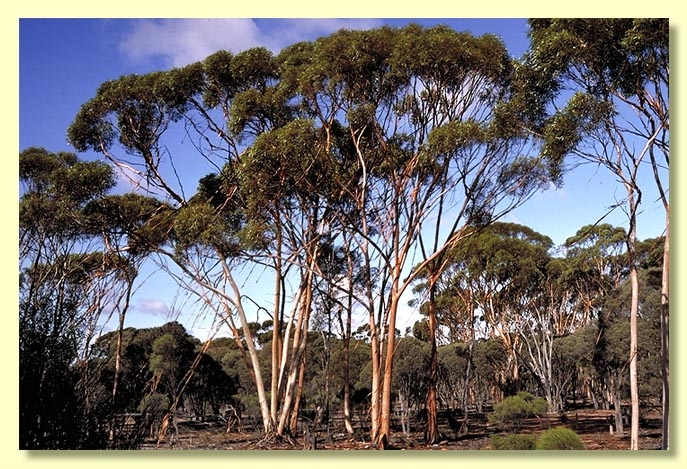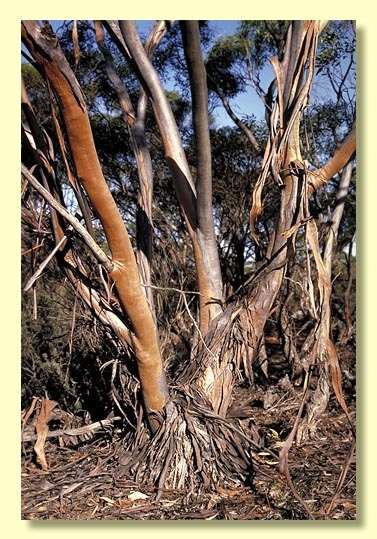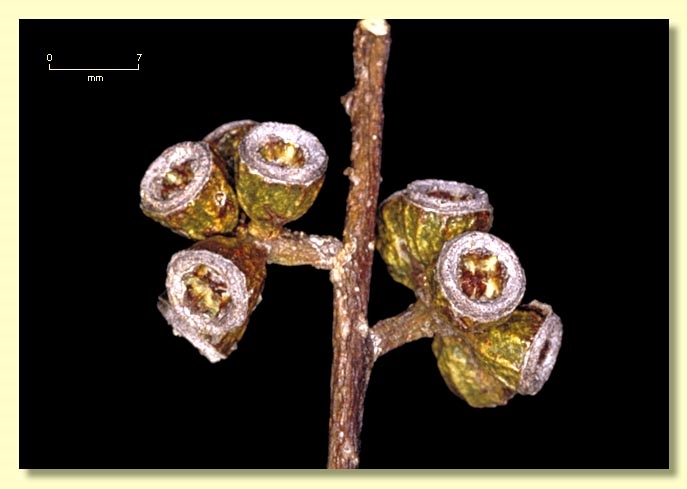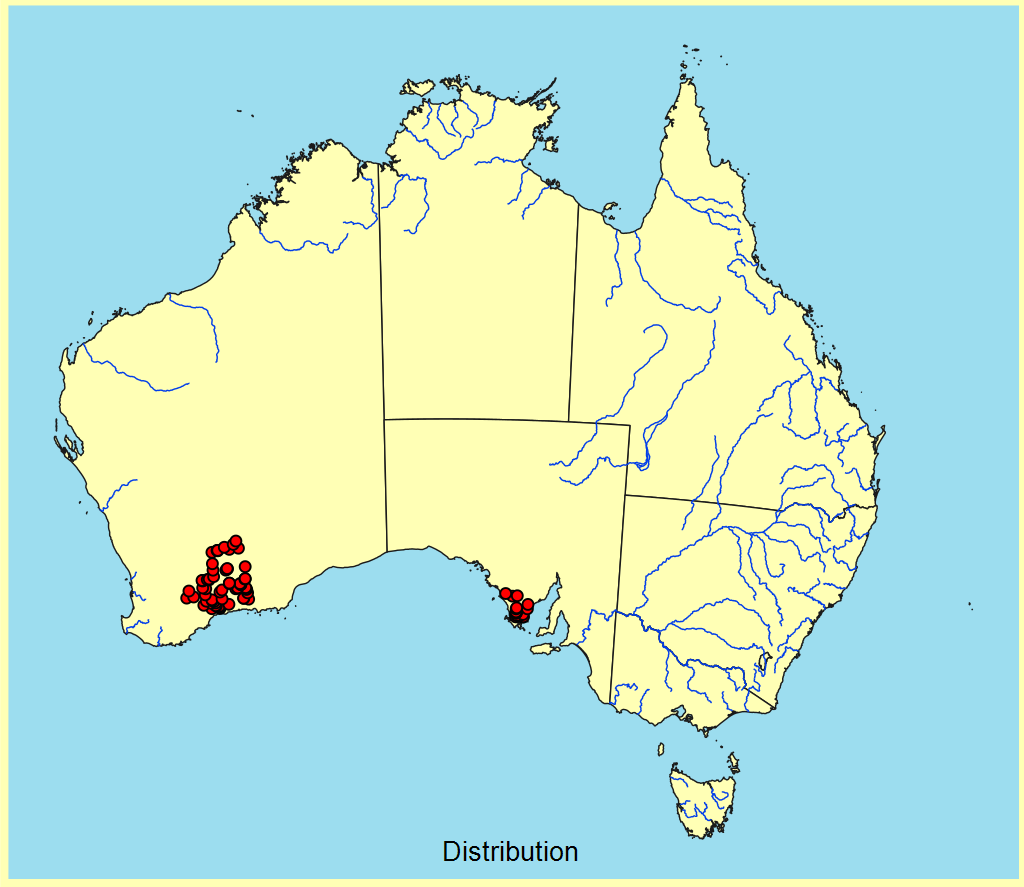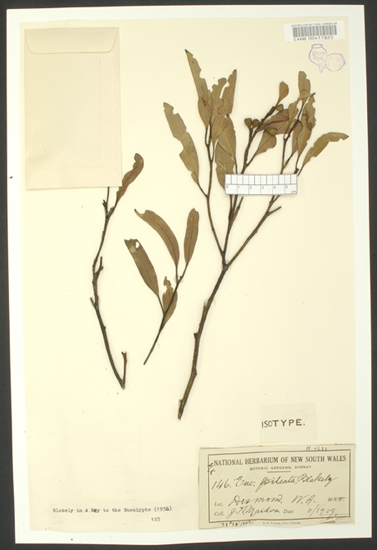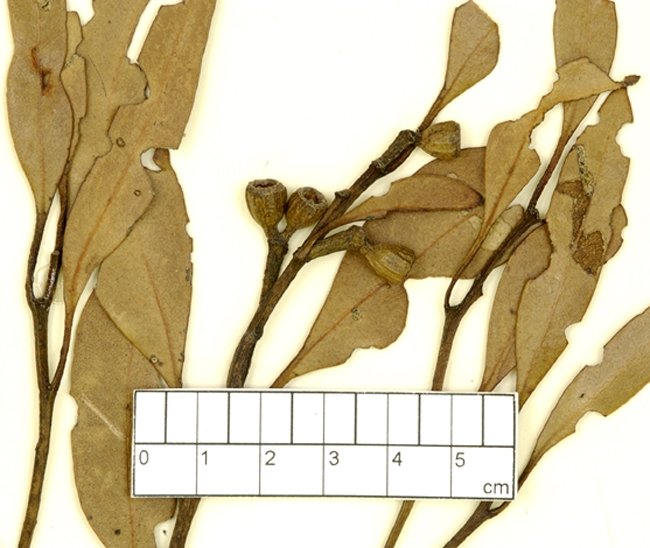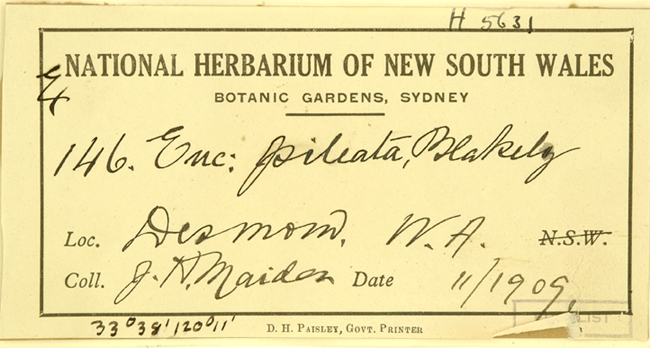Euclid - Online edition
Eucalyptus pileata
Eucalyptus | Symphyomyrtus | Dumaria | Rufispermae
Bark wholly smooth, light grey to grey brown or greenish grey over orange to yellow; shedding in long ribbons conspicuous in springtime.
Branchlets have oil glands in the pith.
Juvenile growth (coppice or field seedlings to 50 cm): stems rounded in cross-section; juvenile leaves always petiolate, alternate, ovate-oblong at lowest nodes soon lanceolate, 5.5–9 cm long, 1–2 cm wide, bluish green.
Adult leaves alternate, petiole 1–1.5(2.2) cm long; blade narrowly lanceolate, (5.5)6.5–14 cm long, 0.7–2.5 cm wide, base tapering to petiole, margin entire, apex pointed, concolorous, glossy, green, side-veins at an acute or wider angle to midrib, reticulation dense to very dense, intramarginal vein present, oil glands numerous, intersectional.
Inflorescence axillary unbranched, peduncles 0.5–1.5 cm long, buds in 7s, pedicellate, pedicels 0.1–0.6 cm long. Mature buds cylindrical to obovoid to pyriform (0.7–1.2 cm long, 0.5–0.8 cm wide), radially striate, scar present, operculum conical to rounded or "turban-shaped", sometimes apiculate (0.2–0.5 cm long), equal to or slightly wider than hypanthium at the join, stamens inflexed, cuboid to wedge shaped versatile anthers, dorsifixed, dehiscing by longitudinal slits, style long and straight, stigma rounded to tapered, locules 4 or 5, the placentae each with 4 vertical rows of ovules. Flowers white.
Fruit pedicellate, pedicels 0.1–0.5 cm long, cupular to obconical or shortly barrel-shaped, 0.6–1 cm long, (0.6)0.7–0.8(0.9)cm wide, disc descending, valves 4 or 5, near rim level.
Seeds reddish brown and glossy, 1–2.5 mm long, flattened-ovoid to slightly angular, dorsal surface sometimes lacunose, smooth to shallowly reticulate, hilum ventral.
Cultivated seedlings (measured at ca node 10): cotyledons reniform; stems square or rounded in cross-section, smooth or slightly warty; leaves always petiolate, opposite for 3 or 4 nodes then alternate, ovate-lanceolate, 6–8.5 cm long, 1.5–3 cm wide, green, dull.
Flowering has been recorded in July, October and November.
A mallee or less commonly a small lignotuberous tree, found in Western Australia where occurring principally on sandplains in southern mallee lands from south of Balladonia to near Ravensthorpe. In South Australia it occurs on the Eyre Peninsula where it can be found in the Port Lincoln–Cummins–Yeelanna area and possibly elsewhere (e.g. Mount Wedge). The bark is smooth and sheds in ribbons, adult leaves glossy green and buds have the operculum consistently wider than the base (hypanthium).
In the classification of Brooker (2000) Eucalyptus pileata belongs in Eucalyptus subgenus Symphyomyrtus section Dumaria having these features: buds initially with two opercula the outer shed early, stamens strongly inflexed, ovules in 4 rows on the placentae and cotyledons reniform. Within section Dumaria the species belongs to a large sub-group of closely related species (series Rufispermae, 37 described species and subspecies) diagnosed by glandular pith in the branchlets, cuboid to wedge shaped versatile anthers, and by the reddish brown and glossy, flattish seeds which are unique to the series.
Eucalyptus pileata may be confused with other series Rufispermae glossy green-leaved mallees: E. phenax subsp. phenax, which is widespread across southern Australia, has shortly pedicellate buds but with the operculum not wider than the hypanthium; on the Eyre Peninsula and subsoastal Nullarbor areas of South Australia E. calcareana differs in its coarser thicker adult leaves, slightly smaller fruit, more frequently has a tree habit and prefers a more arid habitat with shallow calcareous soil (E. pileata prefers a slightly heavier clay-loam soil). In Western Australia E. pileata is a more robust plant than is E. spreta, a steeply branching non-lignotuberous small tree (mallet) from the Fraser Range to Norseman area with smaller buds and fruits compared with E. pileata.
Another Western Australian goldfields endemic species, Eucalyptus distuberosa, is most closely related to E. pileata differing principally in its mallet habit (i.e. the absence of a lignotuber). Plants of E. pileata from the Ravensthorpe area have been recorded as having both mallee and occasionally tree habit and care needs to be taken when identifying the tree form as it can only reliably be distinguished from E. distuberosa subsp. distuberosa by checking for a lignotuber.
Eucalyptus pileata was in some earlier publications regarded as common on the Eyre Peninsula of South Australia but it seems to be quite restricted to the south as mentioned above, on clay-loam soils. On the Eyre Peninsula the glossy-leaved mallees belonging to Eucalyptus series Rufispermae are: E. pileata, E. phenax subsp. phenax, E. calcareana or plants intermediate in form between E. calcareana and ?E. phenax.

